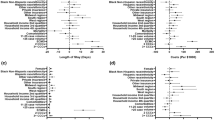Abstract
Background
The impact of published evidence on clinical practice has been understudied in pediatric cardiology.
Objective
We sought to assess changes in prescribing behavior for angiotensin-converting enzyme inhibitor (ACEI) and digoxin at discharge after initial palliation of infants with single ventricle (SV) physiology following the publication of two large studies: The Pediatric Heart Network Infant Single Ventricle (PHN-ISV) trial showing no benefit with routine ACEI use and the National Pediatric Cardiology Quality Improvement Collaborative (NPC-QIC) analysis showing an association between digoxin and survival.
Methods
ICD-9-10 codes identified SV infants from the Pediatric Health Information System (1/2004 to 1/2018) and charge codes identified medications at discharge. Generalized estimating equations implementing segmented logistic regressions modeled medication use, before and after (with a 3-month washout period) the relevant publication (ACEI 7/1/2010; digoxin 4/1/2016). A subgroup analysis was performed for hypoplastic left heart syndrome (HLHS).
Results
ACEI use (37 centers, n = 4700) at discharge did not change over time during the pre-publication period. After publication of the PHN-ISV trial, ACEI use decreased (OR: 0.61, CI 0.44–0.84, p = 0.003). Digoxin use (43 centers, n = 4778) decreased by 1% monthly before publication. After the NPC-QIC publication, digoxin use increased (OR: 2.07, CI 1.05–4.08, p = 0.04) with an ongoing increase of 9% per month. Results were similar for the HLHS subgroup.
Conclusions
Prescribing behavior changed congruently after the publication of evidence-based studies, with decreased ACEI use and increased digoxin use at discharge following initial palliation of SV infants. Our findings suggest scientific findings were rapidly implemented into clinical practice.



Similar content being viewed by others
Data Availability
All data included in the analysis may be obtained through the use of the Pediatric Health Information System (PHIS) database.
Code Availability
Not applicable.
Abbreviations
- ACEI:
-
Angiotensin-converting enzyme inhibitor
- ECMO:
-
Extracorporeal membrane oxygenation
- HLHS:
-
Hypoplastic left heart syndrome
- IQR:
-
Interquartile range
- ISV:
-
Infant single ventricle
- LOS:
-
Length of stay
- NPC-QIC:
-
National Pediatric Cardiology Quality Improvement Collaborative
- PHIS:
-
Pediatric Health Information System
- PHN:
-
Pediatric Heart Network
- SV:
-
Single ventricle
References
Hsu D, Zak V, Mahony L et al (2010) Enalapril in infants with single ventricle: results of a multicenter randomized trial. Circulation 122(4):333–340
Brown D, Mangeot C, Anderson J et al (2016) Digoxin use is associated with reduced interstage mortality in patients with no history of arrhythmia after stage I palliation for single ventricle heart disease. J Am Heart Assoc 5(1):e002376
Institute of Medicine (US) Forum on Drug Discovery, Development, and Translation. Transforming Clinical Research in the United States: Challenges and Opportunities: Workshop Summary. Washington (DC). National Academies Press (US) 2010. Available at: https://www.ncbi.nlm.nih.gov/books/NBK50888. Accessed 4 Aug 2019.
Cabana M, Rand C, Powe N et al (1999) Why don’t physicians follow clinical practice guidelines? JAMA 282(15):1458–1465
Morris Z, Wooding S, Grant J (2011) The answer is 17 years, what is the question: understanding time lags in translational research. J Roy Soc Med 104(12):510–520
Balas E, Boren S (2000) Managing clinical knowledge for health care improvement. Yearb Med Inform 9:65–70
PHIS. 2020. Available at: https://www.childrenshospitals.org/Programs-and-Services/Data-Analytics-and-Research/Pediatric-Analytic-Solutions/Pediatric-Health-Information-System. Accessed 28 March 2020.
Wagner AK, Soumerai SB, Zhang F et al (2002) Segmented regression analysis of interrupted time series studies in medication use research. J Clin Pharm Ther 4:299–309
The R Project for Statistical Computing. R-project.org. 2019. Available at https://www.r-project.org. Accessed 20 September 2019.
Winkler JD, Lohr KN, Brook RH (1985) Persuasive communication and medical technology assessment. Arch Intern Med 145:314–317
Kristensen N, Nymann C, Konradsen H (2016) Implementing research results in clinical practice- the experiences of healthcare professionals. BMC Health Serv Res 16:48
Zak V, Hsu D, Pemberton V, Levine J, Atz A, Cnota J et al (2017) Translating clinical trials into clinical practice: a survey assessing the potential impact of the Pediatric Heart Network Infant Single Ventricle Trial. Cardiol Young 27(07):1265–1270. https://doi.org/10.1017/s104795111600295x
Hansen J, Brown D, Hanke S, Bates K, Tweddell J, Hill G, Anderson J. Angiotensin‐Converting Enzyme Inhibitor Prescription for Patients with Single Ventricle Physiology Enrolled in the NPC‐QIC Registry. J AM Heart Assoc 2020;9
Oster M, Kelleman M, McCracken C et al (2016) Association of digoxin with interstage mortality: results from the pediatric heart network single ventricle reconstruction trial public use dataset. J Am Heart Assoc 5(1):e002566
Callaham ML, Wears RL, Weber EJ et al (1998) Positive-outcome bias and other limitations in the outcome of research abstracts submitted to a scientific meeting. JAMA 280(3):254–257
Acknowledgements
The authors would like to thank the University of Utah Health System and Intermountain Healthcare, as well as the University of Utah Population Health Research (PHR) Foundation, National Center for Research Resources, National Center for Advancing Translational Sciences, and National Institutes of Health.
Funding
This investigation was supported by the University of Utah Population Health Research (PHR) Foundation, with funding in part from the National Center for Research Resources and the National Center for Advancing Translational Sciences, National Institutes of Health, through Grant UL1TR002538 (formerly 5UL1TR001067-05, 8UL1TR000105, and UL1RR025764).
Author information
Authors and Affiliations
Corresponding author
Ethics declarations
Conflict of Interest
The authors have no disclosures.
Ethical Approval
This study was exempt from review by the University of Utah Institutional Review Board.
Consent to Participate
Not applicable.
Consent for Publication
All authors consent to publication of the manuscript.
Additional information
Publisher's Note
Springer Nature remains neutral with regard to jurisdictional claims in published maps and institutional affiliations.
Supplementary Information
Below is the link to the electronic supplementary material.
Rights and permissions
About this article
Cite this article
Weyhrauch, D.L., Truong, D.T., Pinto, N.M. et al. Changes in Provider Prescribing Behavior for Infants with Single Ventricle Physiology After Evidence-Based Publications. Pediatr Cardiol 42, 1224–1232 (2021). https://doi.org/10.1007/s00246-021-02606-0
Received:
Accepted:
Published:
Issue Date:
DOI: https://doi.org/10.1007/s00246-021-02606-0




